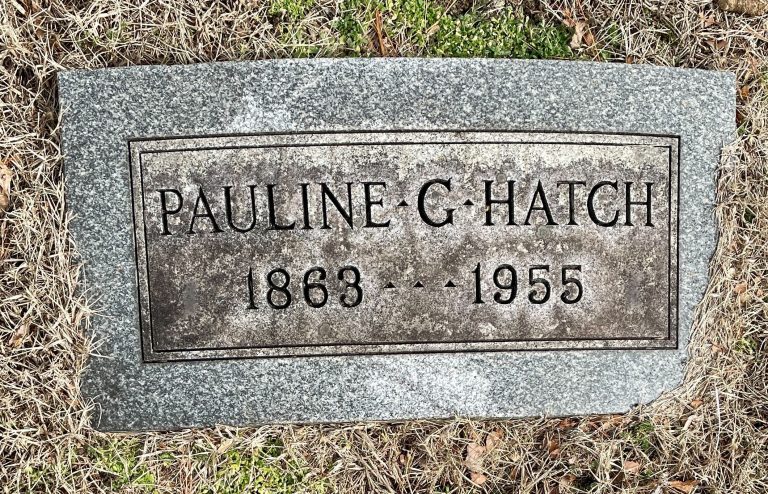Hymn History: Jesus, Refuge of My Soul & Author: Pauline Gilmour Hatch
“Among her best and most popular compositions are Volunteers, to the Front, Our Dearly Loved Banner, Jesus, Refuge of My Soul and Peace Hymn of Nations — all of which show talent of a high order, coupled with thorough scholarship.”
(A. J. Showalter)
The Origin of Pauline Gilmour Hatch’s Hymn *“Jesus, Refuge of My Soul”*
Hymns have often been born out of personal devotion, expressing the faith, hope, and longings of those who write them. One such hymn is *“Jesus, Refuge of My Soul,” a piece that reflects the deep trust of the believer in Christ’s sustaining care. Though less well known than some of the classics of gospel hymnody, this hymn by Pauline Gilmour Hatch has quietly offered comfort and encouragement to congregations for over a century. Its origin illustrates the way one woman’s personal faith, expressed through poetry, was brought into the life of the church through music.
Pauline Gilmour Hatch: Hymnwriter and Poet
Pauline Gilmour Hatch (1880–1955) was an American hymnwriter whose poetry was marked by simplicity, earnestness, and a focus on Christ as the believer’s source of strength. Like many women who contributed to hymnody in the late nineteenth and early twentieth centuries, Hatch was not formally trained as a musician but expressed herself through verse. Her poems, rooted in Scripture and devotional reflection, were later set to music by composers who recognized their potential as congregational hymns.
Little is widely known about Hatch’s personal life compared to more famous hymnwriters, yet her work reflects a steady Christian faith. Hymnologists note that she was among those writers whose words arose more from private devotion than from a public ministry platform. This personal quality imbues her hymns with intimacy, as if she is inviting singers into her own prayers.
The Inspiration for the Hymn
“Jesus, Refuge of My Soul” echoes one of the most enduring themes in Christian hymnody: Christ as the believer’s shelter and source of hope. The title and refrain call to mind passages such as Psalm 46:1, “God is our refuge and strength, a very present help in trouble,” and Matthew 11:28, “Come unto me, all ye that labour and are heavy laden, and I will give you rest.”
Hatch’s text presents Jesus not only as Savior from sin but also as a continual refuge in the struggles of life. The verses speak of storms, trials, and fears, all of which are met with the assurance of Christ’s protection. This theme resonated with late nineteenth-century believers who lived in a time of rapid change and uncertainty, and it continues to resonate with worshippers today.
From Poem to Hymn
As with many hymn texts of its era, “Jesus, Refuge of My Soul” began as a poem. Hatch’s words were later matched with a tune by a composer in the gospel song tradition, making it suitable for congregational singing. The melody chosen was simple, steady, and devotional—designed to underscore the prayer-like nature of the text rather than to showcase musical complexity.
This practice of collaboration between poets and composers was a hallmark of gospel hymnody in the late nineteenth and early twentieth centuries. Writers like Hatch supplied the heartfelt words, while musicians gave them melodies that congregations could learn easily and sing with conviction.
Reception and Use
From its publication onward, “Jesus, Refuge of My Soul” found a place in revival meetings, Sunday schools, and church services. It was particularly well suited to times of prayer and invitation, when the congregation was called to draw near to Christ in faith. Its intimate, personal tone made it appealing in private devotion as well, where individual believers could use it as a sung prayer.
Though it never achieved the fame of hymns like Fanny Crosby’s “Blessed Assurance” or Carrie Breck’s “Face to Face with Christ, My Savior,” Hatch’s hymn has been quietly treasured in the life of the church. Many hymnals from the early twentieth century included it, especially those associated with the evangelical and revivalist traditions.
Themes and Theological Significance
The central theme of “Jesus, Refuge of My Soul” is dependence on Christ. It affirms that while life is filled with trouble and uncertainty, Jesus is an ever-present source of safety and peace. The hymn portrays Christ as both a shelter from life’s storms and a guide who leads believers safely home.
This theme is deeply biblical and timeless. By framing the believer’s relationship to Christ in terms of refuge, Hatch connected her hymn with one of Scripture’s most enduring metaphors for God’s care. For worshippers, singing this hymn is both an act of confession—acknowledging their weakness—and an act of faith—proclaiming their trust in Christ’s strength.
Lasting Legacy
Although Pauline Gilmour Hatch is not a household name in hymnody, her contribution through “Jesus, Refuge of My Soul” has endured. The hymn continues to be sung in certain traditions and has found new life in recent hymnals that seek to preserve the richness of early twentieth-century gospel songs.
Its lasting appeal lies in its sincerity. Unlike some hymns that seek lofty poetic flourishes or theological complexity, this hymn is direct, heartfelt, and prayerful. It reminds believers that at the core of faith lies a simple but profound truth: that Jesus is the refuge of every soul who trusts in Him.
Conclusion
The origin of “Jesus, Refuge of My Soul” reflects the devotional heart of Pauline Gilmour Hatch, a poet who poured her faith into verse. By giving voice to the believer’s need for Christ as a refuge, she created a hymn that continues to comfort and inspire. Though not as widely known as some of her contemporaries, Hatch’s hymn endures as a testimony to the way personal devotion, when set to music, can become a shared song of faith for the whole church. In its words, believers across generations have found strength in the reminder that Christ is both Savior and shelter—the eternal refuge of the soul.
Related
Sorry, no records were found. Please adjust your search criteria and try again.
Sorry, unable to load the Maps API.

